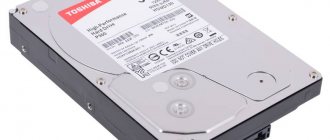As you know, the more careful you treat a device, the longer it can serve its owner. This unspoken rule is also true for laptops, especially its battery.
For obvious reasons, a laptop battery is one of the most important parts of the entire device. Even though it may be made using quality materials, its maximum service life is around 5 years.
And if you don’t take care of it, then you can use it for even less time. This is primarily due to improper charging of the device’s battery.
What are the types of laptop batteries and how to charge them
Before we talk about how you should (or should not) charge the battery of this type of equipment, you need to understand what type is installed in the laptop.
After all, the recommendations greatly depend on what main power source is installed. They come in three types - each with its own advantages and disadvantages.
Nickel-Metal Hydride Laptop Battery
They are also designated as Ni-MH. Most often, this alkaline energy source is used to power digital equipment, children's toys and other household appliances.
You can now see such a battery in a laptop only in fairly old models, and charging them is out of the question.
In the current generation of these devices, Ni-MH is no longer used, as it has modest energy consumption and service life.
Laptop battery Ni-CD
Nickel-cadmium power supplies are also not as popular as laptop batteries. It is extremely rare to see them now.
Their main field of use is in powering portable tools (drills, electric saws, grinders), and the same for vehicles with ultra-high power. But this type of battery hardly needs to be charged at home.
Lithium-ion laptop battery
The most common power sources. They can be found not only in these types of devices, but also in smartphones, photography equipment and other devices.
The reason for their popularity is their durability, good energy reserves, and compact size (which is especially important for laptops).
They can be charged and discharged up to 1000 times, this is a guaranteed safety margin. Typically, such a reserve is enough for several years of trouble-free operation.
In addition, Li-Ion batteries have low self-discharge rates. This can be considered their huge advantage, since laptops can remain idle for a long time (or they may not be charged for a long time), which means their charge level drops minimally. Therefore, for laptops that are used offline, they are of greatest benefit.
How to properly charge a laptop battery without a charger?
There are situations when you need to charge your laptop battery, but you don’t have a charger with you or you are away from electrical networks.
Below are several ways to charge a laptop battery without a charger. Are you wondering whether it is possible to use a laptop without a battery when powered from the mains? Then read the article at the given link.
Charging a laptop battery in a car
This option for charging a laptop battery is suitable for those who spend a lot of time in the car. There is no socket in the car and the generator in the on-board network produces a voltage of no more than 14 volts. But the situation can be easily corrected by purchasing a portable inverter.
Car inverter for charging
These devices are made under the cigarette lighter and convert the voltage into several output options. Ideally, choose an inverter that can provide an output voltage of 20 volts (most common laptops have a battery rating of 19 volts). There are 110 and 220 volt inverters. It is better to take a device with an output for the laptop’s power connector. If you charge via USB, then due to the current limitations of this interface, charging will take a lot of time.
Another disadvantage is the fact that you can charge the laptop battery through an inverter only with the engine running. That is, the option is ideal for charging on the go.
We advise you to read about why the battery on your laptop does not charge.
Solar battery
A solar battery for charging a laptop will come in handy outdoors. This is quite an interesting option to extend the battery life of a laptop.
Solar battery for a laptop
Today there are quite a lot of portable solar batteries for mobile electronics on sale.
The operating principle of such devices is the conversion of solar energy into electric current. Models that are capable of producing an output voltage of at least 19 volts are suitable for a laptop. They are very easy to use. The solar battery is connected to the power connector of the laptop and the panels are placed under the sun. The advantages of this method include convenience, mobility and free solar energy. Disadvantages include the need for clear weather and bright sun. Otherwise, the charge will be slow. In addition, the solar battery is only suitable for charging the laptop battery. She won't be able to work. Therefore, the option is suitable in case of prolonged exposure to nature.
Charging from an external battery
An external battery is a portable device, often called a power bank. On average, such devices can give you another 2-3 hours of additional laptop work.
External battery for a laptop
Read more about choosing an external battery for a laptop in the article at the link. There is a large selection of such devices on the market. They have gained popularity due to the fact that they do not depend on weather conditions and are compact in size. When purchasing, we advise you to pay attention to the various adapters included. If, in addition to a laptop, you are going to charge a smartphone and tablet, then the external battery should have several ports with different output current values. To charge a laptop, you need an interface with an output current of at least 2.5 amperes.
Charge a laptop battery: how to do it correctly
In order for a laptop battery to fully use up its allotted resource, it is necessary not only to use it correctly, but also to charge it.
First of all, batteries are damaged by such things as uncertified chargers, as well as adapters (including homemade ones), plus if you charge the laptop from them constantly.
Don’t forget that the device should only be sent to professionals for repair. Amateurs most often break the power supply when trying to repair it.
Is it possible to charge a laptop using a Power Bank?
A laptop is a convenient portable device that we can take with us both to work and on travel. But the problem lies directly in the battery charge, the volume of which, at best, lasts for 3-4 hours. To the question whether it is possible to charge a laptop from a Power Bank, the answer is unequivocal - yes! Technologies are improving every year, and now no one will be surprised by the creation of a portable charger (Power Bank), which can compensate for the lack of a nearby electrical power source, which solves many problems for the laptop user.
It should be noted that not every such device can become your faithful assistant when charging your laptop. To do this, the Power Bank must have the necessary characteristics or be specialized for charging a laptop. Let's figure out how to charge a laptop via Power Bank.
If you have just purchased a laptop
This is the most preferable option, since the laptop battery was practically not charged, which means that the resource was not used.
Also included as standard is an original adapter that allows you to replenish energy without any problems.
In order to charge it, you just need to connect the adapter to the appropriate socket and plug it into the electrical network. With standard chargers, no problems should arise during use.
The battery currently used in laptops does not have the so-called “memory effect”. Accordingly, there is no need to start “rocking” it, i.e. Fully charge and fully discharge the battery two or three times. Therefore, there is no need to do any “dancing with a tambourine” when charging. If charging is necessary, simply connect the adapter to the laptop, and its plug to the mains power supply and wait until the battery is replenished to the required level.
However, just for fun, you can conduct a small experiment with a new laptop. To do this, you will need to fully charge the device, up to 100%, measure the time in any convenient way, and use it in standard mode, bringing it to 0% charge (then compare the actual operating time and the one declared by the manufacturer). This will allow you to plan your work with the laptop much more clearly and roughly understand how much it will be enough for autonomous work.
If the device is used every day
Despite the fact that these batteries have a lot of positive aspects, they are not without certain problems. Thus, one of the main problems of Li-Ion batteries is that they have a rather limited discharge-discharge cycle.
Even though it can survive 1000 such cycles (which is not too little), it still begins to develop its accumulation properties. This entails the inability to use the device autonomously for as long as before.
The only advice that will help “stretch” the operating time of the battery is that you should not completely discharge the battery and charge it to the limit.
If your laptop is constantly in use, then as soon as the level drops to 20% or below, it should be included in the charger.
This will also make it possible to extend its “period” of life significantly longer than that same thousand cycles (which means it can be used autonomously for longer).
There is also a little trick that will increase the life of the battery. The built-in controller found in the laptop system turns off charging as soon as the indicator reaches 100%. However, if you manually (or using some programs) turn off battery charging at 80%, you can significantly increase the battery life.
Of course, this will somewhat reduce the usability of the laptop, but it is better to work a little less than to have problems with the battery in a few years.
Is it possible to constantly charge a laptop from the network and is it harmful?
There is an opinion that if you remove the battery during stationary operation (when the adapter is constantly connected to the network and charges the device), it will last much longer. And many believe in such untested theories.
In fact, everything is somewhat more prosaic and simpler. If the adapter is constantly connected to the network (and therefore charges the laptop), then the battery is not involved in this process and, accordingly, does not consume its resource.
However, the question arises: where does the energy go in this case?
It's simple. When a laptop is charged in this mode, the battery resource is practically not used, since it falls out of this energy supply scheme.
Instead, all the power that comes in is transferred to the motherboard, which can cause the battery to last much longer than usual. However, this rule is only relevant for modern laptop models.
Older versions do not have such an electrical circuit, and therefore, as soon as the battery is charged, the controller turns off and the device begins to work in autonomous mode.
How to properly charge a laptop battery
The battery will be able to fully work out its life only if no serious errors were made during operation. First of all, you should not charge the battery with homemade and uncertified adapters, and also trust laptop repairs to non-specialists.
New laptop
If the laptop is purchased in a store, then the kit includes a special adapter with which you need to charge the standard battery. To fully charge the laptop, just plug in the charger and connect the output part of the cable to the corresponding socket of the laptop.
Modern Li-Ion batteries do not have a memory effect and do not require charging, so you can safely start using your laptop right away and charge it at any convenient time. That is, you don’t have to wait until the laptop sits down and then charge it.
Still, for the sake of curiosity, you should fully charge it for the first time and then note how long it takes for it to discharge during your normal use. This will help you understand how much the gadget’s operating time in offline mode differs from those declared by the manufacturer, and you will know its real resource.
The correct order for storing laptop batteries
If there is a need to store the battery separately from the device, you must follow a few simple rules. Before sending the battery for long-term storage, it is necessary to charge it to 80% (or better yet, to 100%).
This is necessary so that the battery can survive this time when it is not in use. Of course, Li-Ion has a low level of self-discharge, but it is still present, and therefore it is not recommended to put it away completely.
It is especially important to note that the level of self-discharge will begin to increase significantly if you store the laptop battery in a damp room.
It is best to choose a heated room for this matter, since temperature changes negatively affect the battery. If necessary, you should charge it once a week or several times so that the charge does not drop below 80%.
It is also worth monitoring the temperature at which the laptop battery is stored. Immediately exclude places that receive direct sunlight, near heating (batteries or special devices) or simply on a windowsill, since overheating has an extremely bad effect on the performance of this device and reduces its performance. It will be bad if you overcool the battery.
If you do not charge the battery before storing it, it may happen that it goes into a deep discharge. It is similar to the one found on cars, and it can only be “revitalized” by turning to specialists for help (since the controller simply will not be able to see the battery and will not allow it to charge).
Do I need to remove the battery from my laptop?
All laptop batteries are designed for a certain number of charging cycles - we will not give numbers, they can vary greatly. Each such cycle is equal to one complete discharge of the battery to zero and a further charge to one hundred percent. A discharge to 50% and a further charge to 100% is equal to half a cycle. Over time, each such cycle reduces the battery capacity.
Read also:
How to improve the Wi-Fi signal in an apartment?
There used to be a problem called “battery memory effect” that plagued nickel-metal hybrid and nickel-cadmium batteries. When discharging and charging incompletely (from 0 to 100%), they “forgot” their capacity and began to charge worse and hold a charge worse. However, now this problem of capacity loss no longer exists, since modern devices use completely different batteries, namely lithium-ion and lithium-polymer.
Also, modern batteries are not overcharged, since when the charge reaches 100%, the power controller turns off the current supply. But debate about how to properly charge a laptop still remains.
- So, the answer is: there is no need to remove the battery from the laptop while working from the network! Or rather, it is necessary, but in some cases: for example, if you are going to work at the computer for a long time. This is due to the fact that, being constantly charged, the battery is under high voltage, which “ages” the battery. It is also better to remove the battery if the room is hot and it gets very hot - this also leads to loss of capacity and wear out of the battery. For example, temperatures above 45 degrees generally contribute to battery degradation. Computer games and working with videos also often lead to overheating of the laptop.
If you work with text, watch pictures or movies on the Internet for a short period of time, then it is not necessary to remove the battery, since the built-in controller will automatically limit the current supply.
Another option when you need to remove the battery is when you send it to the “closet” for long-term storage, for example, when going on vacation. It is important to do this correctly: charge the battery to 40-50% and put it in a cool, dark place - this will help protect the lithium battery chemistry from destruction. But inactivity should not be too long - depending on the remaining charge, from 5 months to six months (with a loss of approximately 8% of the charge per month). After this period, the battery must be properly charged.











